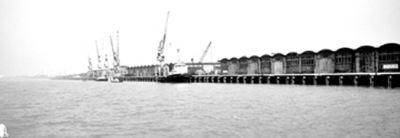Mongla Port
Mongla Port the second largest seaport, 48 km south of Khulna town. The port was developed initially about 18 km up at Chalna, which was opened to foreign vessels as an anchorage on 11 December 1950. The anchorage was shifted to Mongla in 1954 as the place could accommodate sea-going vessels with greater draughts. The port of Mongla had long retained its name Chalna. Mongla is situated on the confluence of the rivers pasur and Mongla at mouza Selabunia of rampal upazila of bagerhat district. During the Pakistan period, the administration of the port was under a port director, whose main office was at Khulna.

Sea-going vessels up to a draught of 25 feet could berth vessels here and those with a draught up to 17 feet were allowed to anchor. Although fairly small, Mongla was a busy port in the past and at times, about two dozen sea going vessels were found anchored here. Later, especially since 1980, the port often remained closed because it lost proper depth required for the ocean-going ships and every time it was reopened after dredging. At present, about 400 ships berth at the port in a year and the port annually handles about 3 million MT of imports and exports. The port has 11 jetties, 7 shades for loading and unloading of goods and 8 warehouses. It uses 12 swinging moorings or floating berthing places in deeper sections in the river. The Mongla Port Authority that now administers the port constructed a rest house for the seamen at a place named Heron Point.
The port has trade links with almost all major ports of the world, although vessels arriving here are mostly from ports of Asia, the Middle East, Australia, Europe and North America and the ships rarely come to Mongla from the countries of Latin America or Africa. In addition to promotion of imports and exports of the country, the port contributes to development of many industries and trading houses in surrounding places and along with this, of new infrastructures and job opportunities. Many local people are working in the port directly in loading and unloading vessels. [Syed Md Saleh Uddin]
